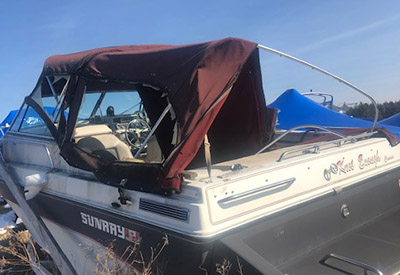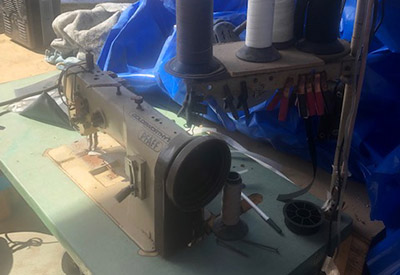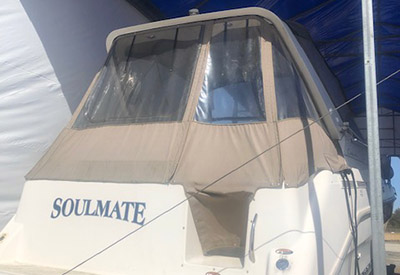Ask Andrew: Canvaswork – covers, dodgers and biminis

Apr 8, 2021
Each spring, I tend to notice canvas. I wish it were because it’s been immaculately maintained and looks perfect when installed. I notice it because it’s a pain. Shrink wrap and tarps are removed, canvas is installed. Strataglass is fogged, rips and tears are evident, zippers are broken. In short, repairs are required. Lets face it, boat canvas takes a beating: it’s exposed to the elements: wind, rain and sun – and it’s maintenance is often overlooked in favour of more pressing ‘Let’s go boating’ needs.
All of that said: when you’re setting up your bimini, dodgers, mooring and sail covers – you may have questions and concerns – and you may be thinking about repairs.
As with many boat projects, there is always the question of DIY vs contractor.
If you’re thinking DIY, it may be simpler than you think (which I’ll get to in a moment) – but DOES require (in many cases) a bit of an investment: An industrial-style sewing machine, capable of running appropriate stitching. A home machine simply wont cut it.
Creation of a new dodger, bimini or panels can be completed in a few straightforward steps, using basic tools and equipment:
- Check the frame. You may be making a new frame, you may be repairing or modifying an existing frame: Either way, make sure that it’s set up in a way that is tight, with dimensions and pole positions in a way that allow free movement around the boat. Make sure that any hardware installed in fiberglass is bedded appropriately with a high-quality sealant used
- Use plastic sheeting to make a template – lay plastic sheeting (and tape in place) on the frame. Measure, mark, measure again, and cut sheeting in appropriate layout.
- Determine where zippers, windows and solid cloth areas will be and mark on template
- Cut the canvas and Strataglass to match template design and sew! Keep in mind appropriate cloth length for seams, zippers, and for the ‘pockets’ used to allow the canvas to zip on and off the frame
- Install on frame, and layout where the canvas and boat snaps will be installed. Keep the canvas stretched as tightly as possible, and work your way methodically from one end of each section to the other
 Tools/Equipment you’ll need:
Tools/Equipment you’ll need:
- Sewing machine for any stitching (along with thread, needles, etc)
- Scissors and stitch removers
- Plastic drop sheet for template
- Double sided-tape to hold things in place, and to keep seams together where required
- High-quality canvas and Strataglass
- A ‘Snap’ tool, for installing/pressing snaps in the canvas
- Screws and grommets for installing snaps onto the boat
- Sealant to appropriately bed the grommets into the fiberglass
There are a number of great online tools and tutorials available to – my favourite is www.sailrite.com – a great resource to find tools, supplies and DIY tips and tricks.
Commissioning new
 If you’re less interested in repair, and more interested in other boat maintenance concerns, you may want to have covers, cushions, and canvas repaired by a contractor. A quick google search (in my case ‘Boat Canvas Toronto’) provided more than a dozen options, with varying levels of options and repute.
If you’re less interested in repair, and more interested in other boat maintenance concerns, you may want to have covers, cushions, and canvas repaired by a contractor. A quick google search (in my case ‘Boat Canvas Toronto’) provided more than a dozen options, with varying levels of options and repute.
A few other ways to find a contractor:
- Marina/yacht club recommendations – if you see a set of canvas that looks great, ask the owner (or search for the label/tag that is often sewn onto professionally done canvas.
- Yacht club/marina posting boards: if you see a posting on your club board, you can be relatively certain that the poster has been onsite and has done work for one of you fellow members
- Boat shows: a great place to meet contractors face-to-face and see examples of their work
- Your local chandlery – many offer in-house repairs, or can refer you to a preferred supplier
Cleaning/Maintenance
This article started with the condition of canvas in the spring – and this is when maintenance (or lack thereof is most evident). Here are a few tips/tricks to keep your canvas in great condition:
- Always check and follow the recommendations of the supplier. When I say this, I mean, the supplier of the canvas materials and the Strataglass. Use the appropriate products that will keep canvas and glass looking sharp. Most recommendations that I’ve seen indicate a simple soap and water solution, with a soft brush. Occasionally re-apply a fabric guard (to stay water repellant).
- Watch the weather – especially temperatures. In low (freezing level) temperatures, Strataglass tends to break and shatter in a cold weather
- When storing for any period of time – clean the canvas, allow them to dry, and hang or lay canvas panels flat, and separate panels with craft paper.
 Andrew McDonald is the owner of Lakeside Marine Services – a boat repair/maintenance firm based in Toronto. Andrew has worked in the marine industry for 12 years and is a graduate of the Georgian College ‘Mechanical Techniques – Marine Engine Mechanic’ program.
Andrew McDonald is the owner of Lakeside Marine Services – a boat repair/maintenance firm based in Toronto. Andrew has worked in the marine industry for 12 years and is a graduate of the Georgian College ‘Mechanical Techniques – Marine Engine Mechanic’ program.
Questions or comments for Andrew? Email him directly via: askandrew@lakesidemarineservices.ca




























